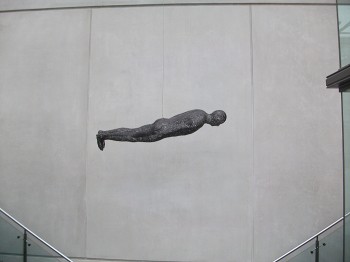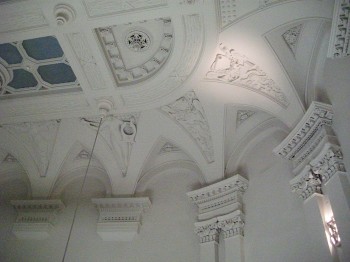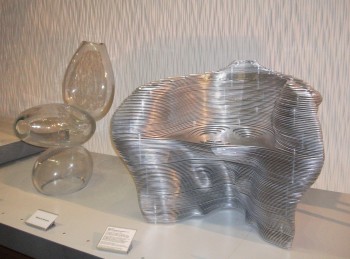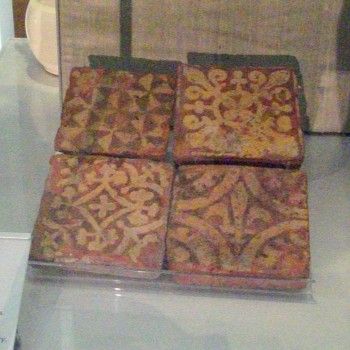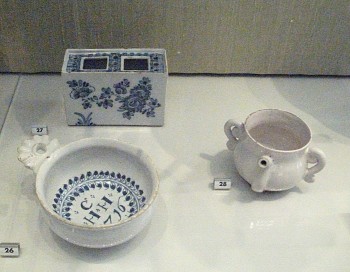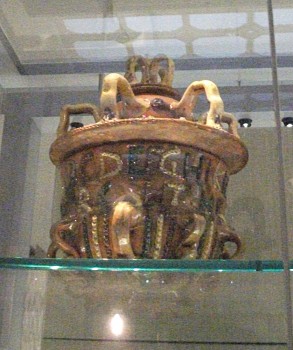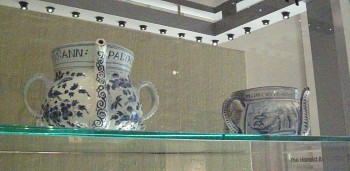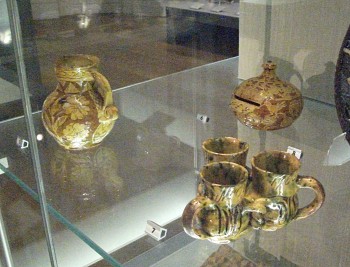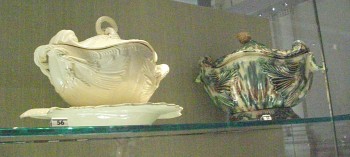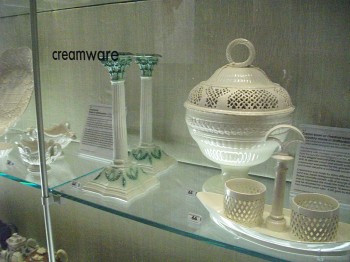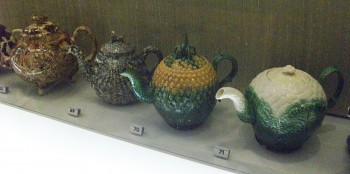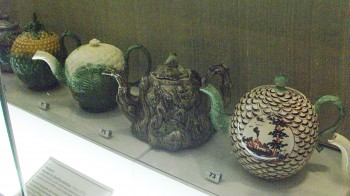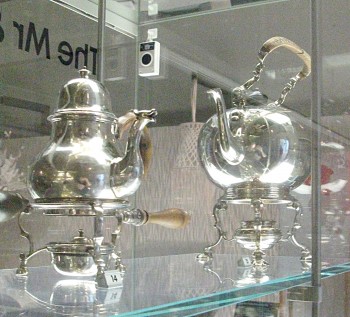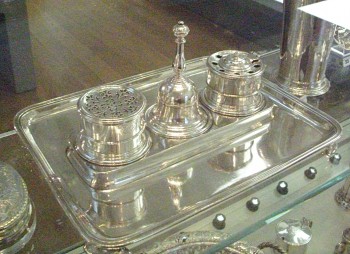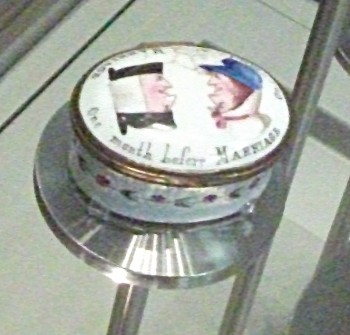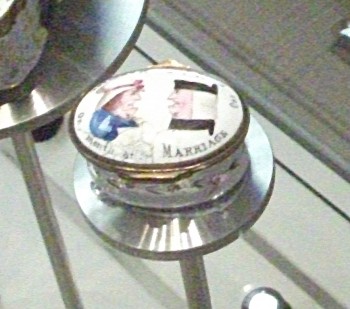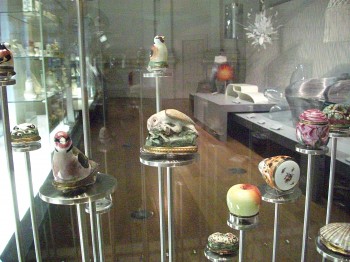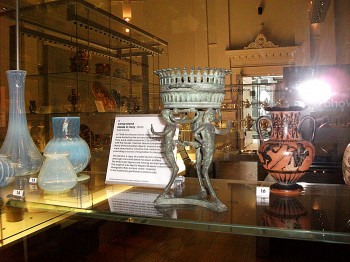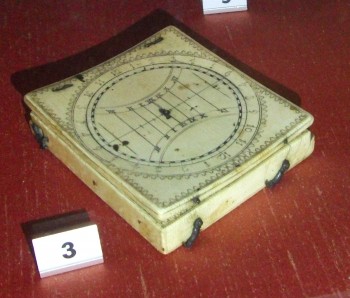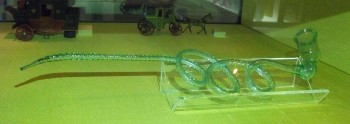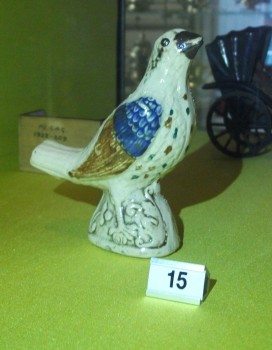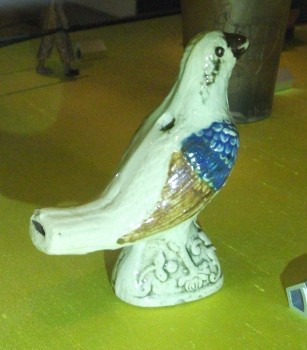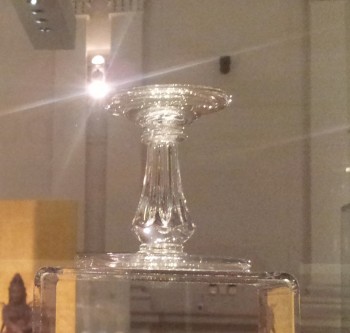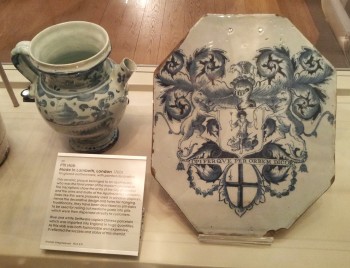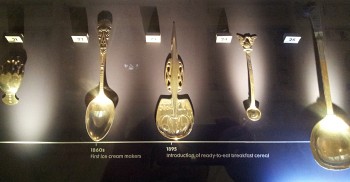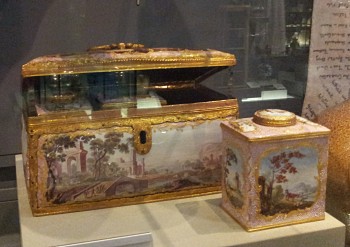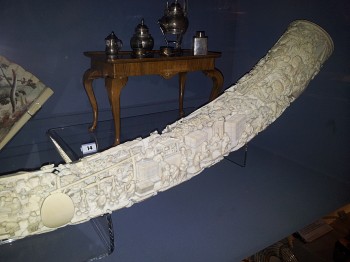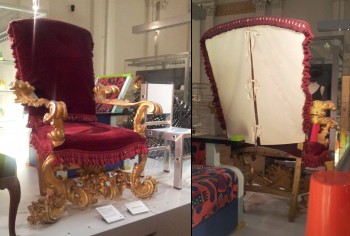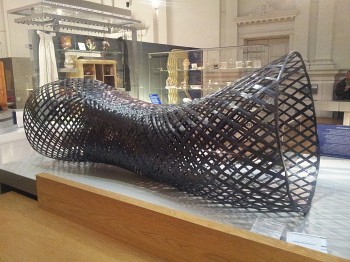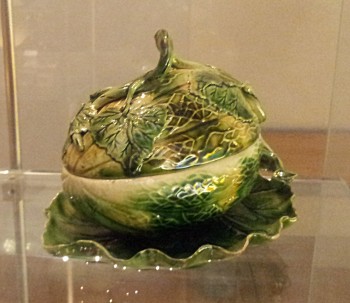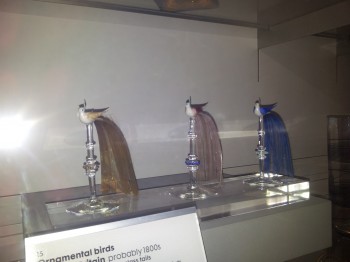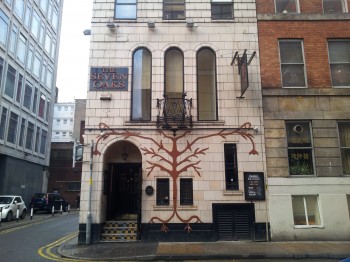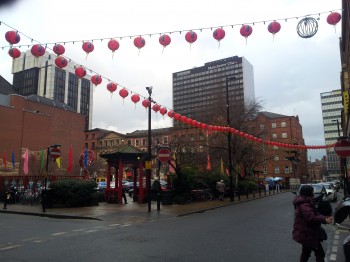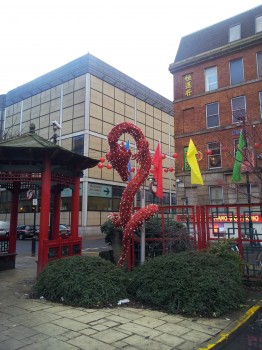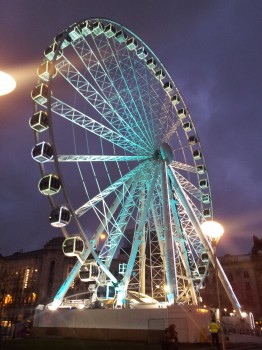As I mentioned last week, I went to Manchester Art Gallery with Glossopdale WI, where I thoroughly enjoyed the Gallery of Craft and Design. I got completely absorbed in that section, and took a ton of photos.
Upon arrival, we stopped in the cafe for a drink first, and then made our way upstairs. Be sure to click on the photo & then the right arrows to follow the narrative.
I’ve done what I can with these photos; they’re not brilliant, but these things are just too neat to not try to share. The lighting is absolutely terrible in that room – I was struggling to see many things with my eyeballs, forget about through the lens. Things behind glass are always difficult to photograph; moreso when they have no opaque backing, making the background difficult to control. I tend to prefer not to use my flash on old things, though I except certain materials like silver where I don’t think it makes a difference. And then, just for kicks, my camera batteries ran out at lunchtime, so the rest of the photos were taken with my cell phone – thankfully it usually takes acceptable photos.
- Went to the Manchester Art Gallery on 22 Jan 2014.
-
After stopping in the cafe for a drink, we headed upstairs – rumor had it that the exhibit we were there to see was on the top floor. Getting off the lift, this figure greeted us. It’s called Filter, and Antony Gormley made it. Seeing as I don’t generally like modern art, I know nothing of this chap; he is apparently the one who made the (in)famous Angel of the North.
The sign said:
Filter is made of mild steel rings welded together. This “skin” acts as both a container of the body and as a space for our own thoughts and feelings.
Must say I am wondering what mild steel rings are – mild as in, not spicy? Not passionate? Not hot? Hm.
The sculpture’s suspension suggests flight, levitation, or an out of body, spiritual experience. Inside is a form located in the place of the heart, symbolically associated with life, death, and love.
Another sign said that the artist wrote this about the work:The work hangs in space as if in orbit, open to light and the elements. At its core in the heart position, there is a condensation of balls whose diameter is equal to the internal right dimension that makes the outer membrane.
Wow, I didn’t get any of that from this figure of a naked man suspended by his butt over a staircase. Call me silly, but if you want to explore the relationship between the core of the body and space, or the relationship between emotion and spatial experience, I daresay the best medium to use could quite possibly be words – unfashionable, antiquated things they may be.
Filter is amongst the first works where the skin of the body volume is transformed to a porous surface and external context. The work is a meditation on the condition of the relationship between the core of the body and space at large. It suggests that while movement, freedom of choice, and the exercising of will is one way in which life expresses itself, there is another axis: the relationship between emotion and spatial experience.
- Only one of the rooms on the top floor was open – I guess they’re changing an exhibit in the other room – so that’s where I went. What drew my attention first was the absolutely stunning ceiling. I adore this ceiling, and fancy having one in my house one day. Upon saying so to one of my fellow WI members, she said I’d have to think about how to dust it: I’d need a duster on a long stick, or something. Hah. Once I can afford a ceiling like this – and the room to match – I’ll be paying someone to dust it!
-
“Please do not touch” the sign says. Bah. I like that steel chair – complete with butt cheek divets! – and really wonder what it’d feel like to sit in it. Likely not too comfy if your butt isn’t that shape. It’s made from some huge number of individual layers of steel, I believe it was (my photo of the sign didn’t come out so well).
The glass thing, however, is just weird. Each piece was apparently hand-blown!
-
That would make an interesting dining room chandelier – would probably be a decent conversation starter.
Chris, in his usual spoil-sport fashion, has decreed that we can’t have one. Phooey. (Some nonsense about needing a bigger dining room or something – bah!)
-
Stepping away from the modern art, I found the Thomas Greg collection of pottery. These four floor tiles were made in England in the 1300s. The sign says they’re earthenware, with inlaid decoration.
I exclaimed over the age of these to a friend nearby, and she asked if it still gets me, how old things are here. 1300s? Yes, that grabs my attention.
-
What are these? Once I found this section of the room, I perked right up. All the strange dishes and objects our ancestors never cease to entertain me.
The one at the back: can you make out the three rows of smaller round holes beside the square ones? It looked vaguely like a toothbrush cup to me: skinny toothbrushes in the little holes, and then toothpastes in the big holes. The book says it’s an inkwell, from the 1750s.
The round thing on the left is a bleeding bowl from 1716. Fun times!
The round thing on the right is a “feeding cup” from the 1670s. Looks like a sippy cup to me, almost. That nozzle almost looks like an elephant’s trunk, really.
-
What are these?
Delftware, or Delft pottery, denotes blue and white pottery made in and around Delft in the Netherlands and the tin-glazed pottery made in the Netherlands from the 16th century.
From about 1615, the potters began to coat their pots completely in white tin glaze instead of covering only the painting surface and coating the rest with clear ceramic glaze. They then began to cover the tin-glaze with clear glaze, which gave depth to the fired surface and smoothness to cobalt blues, ultimately creating a good resemblance to porcelain.Have you figured it out yet?
They’re candlesticks. I exclaimed to a friend when I found that in the book, “All that for a candlestick?!” She pointed out that, just as we have fancy lamps and chandeliers today, they would’ve had fancy things to hold their sources of light back then. The shelf halfway up puzzles me a bit, though finally it occurred to me that they had worse candles than we do today – not necessarily clean-burning, so a whole shelf to catch drips, etc, was probably useful. I also wonder if it made it easier to carry, if you grabbed it between the shelf and the base.
-
What is this!?
The book says it’s a posset pot and cover from 1707. Posset was a mixture of heated milk combined with ale or wine, which curdled it; in the Middle Ages it was given as a remedy for colds and certain other things. Mmm, curdled milk.
Chris reckons the pot has so many handles to help the really ill hold on to it. I’m not sure if posset was still being given as a remedy by 1707, but all I know came from that wikipedia article.
It sure is a bizarre thing, though!
-
These larger versions of that sippy cup are also marked down as posset pots. I do begin to suspect that they were perhaps really just jugs (pitchers), used for multiple things, just as our own pitchers are today.
-
What are these?
The thing at the top left of the frame is simply a jug. The thing at the top right of the frame, however … what could it be?
It’s a moneybox (piggybank). I couldn’t twist around well enough to see if there was some mechanism for opening it on the bottom – I do hope there was!
But what of the thing in the lower right of the frame? My picture doesn’t show it too well, but it’s as if the potter made three small cups (little bigger than shotglasses), each with a handle, and then stuck them together with extra clay sort of randomly applied (though there’s a hole in the middle between the cups), before glazing and firing the lot. Hm…
It’s a fuddling cup, and thanks to wikipedia, now I have a clue about what that is!
A fuddling cup is a three-dimensional puzzle in the form of a drinking vessel, made of three or more cups or jugs all linked together by holes and tubes. The challenge of the puzzle is to drink from the vessel in such a way that the beverage does not spill. To do this successfully, the cups must be drunk from in a specific order.
- A couple of ornate tureens (vessels for serving soup or stew).
-
Ever since I went through these photos, showing them to Chris, I’ve been kicking myself for not getting a proper photo of that plate at the left edge. The detailed relief design was stunning. Something for next time!
Creamware is a cream-coloured, refined earthenware created about 1750 by the potters of Staffordshire, England, which proved ideal for domestic ware.
I was taken with the intricate design on the large bowl thing, too, and amused by the description on the sign: “Cream bowl or chestnut bowl.” They don’t really know what it was used for, it sounds like – probably whatever its owner felt like each day! I do wonder about number 66 there – all I can think is candle holder, but then, I think tealight candles are too new for that. Hm.
-
Novelty teapots! They’re fab!
When I was showing these to Chris, he said he was so glad we don’t have a novelty teapot. I asked why, and he said it’d be too silly. Well, then, it’d suit us! Now he gets to live in dread of each shopping trip I make, til I find a suitable novelty teapot… bwuahaha!
-
I won’t, however, bring home a novelty teapot in the shape of a tree stump (even if it is from 1770), rest assured! The sign said:
Novelty teapots are older than you might think. Tea drinking became popular in the 1700s and tea parties were fashionable social events. Tea was something unusual, exotic, and costly, and an excellent subject for witty design. Teapots were made in all sorts of shapes, following the changing fashions of the time.
This teapot is made to resemble a tree stump, with gnarled handle and spout and patches of moss. Or is it a rock pool, with a shell on the lid and seaweed fronds clinging to the sides?
-
Then I headed over to the dazzling silver collection from Mr and Mrs Edgar Assheton Bennett. These teapots with lamps under them seem emminently sensible for keeping the tea warm – I do wonder why we got rid of this idea! This is far classier than a tea cozy.
-
It’s an inkstand for the well-to-do — aside from being made of silver, this is an inkwell, a pounce pot, and a bell – I presume to ring the butler when you’ve finished writing to take your missive on its way!
I’ve never heard of pounce before; apparently it was used to smooth rough paper, to make it smooth enough to write on with a quill or steel nib. That wikipedia entry says that paper is usually smoothed (sized) with a gelatinous layer to make it smooth enough to write on. Huh, I never knew that.
All I can think of looking at this picture, though, is how much wasted desk space there is with this stand!
-
The tall thing is a beaker, the book says. Chris says it can’t be; it doesn’t have any mL markings on it. I suspected the beaker predated milliliters, and I was right: the beaker is from 1601; the metric system was introduced in 1799. ;-P
I’d just heard a friend say something about drinking half a beaker of water a few days before I saw this, so this beaker caught my eye. I think some people use beaker to mean drinking cups, rather than just meaning the laboratory equipment I think of.
The small cup at the front is a quaich, which is for drinking out of, even if it does look very similar to the bleeding bowls.
The round thing at the back is a wine taster, apparently – wonder what my guests would do if they asked for just a taste of some drink and I put an ounce or so in a saucer for them!
The cup at the front is a wine glass. I can’t remember now if that decoration punched the whole way through – I hope not!
-
This is a steeple cup, apparently. (Ignore the sign; that’s for the object to the right, which you can’t see.) Wikipedia has failed me on this one, so any illumination would be gratefully received. Barring some other explanation, I’ll continue believing Chris’ hypothesis: it’s so you can have your drink and then stab your drinking buddy. Suppose that’s one way to not have to share.
-
These were cool to look at. They’re from 1688.
This is a portable candle maintenance kit. Before the introduction of the non-guttering wick, candles needed constant attention to keep them lit.
The stand contains a pair of scissors or snuffers to trim the burnt wick into a small box on one blade. The scissors have pointed ends to gouge out any stumps of wax left in the candlestick. There is also a conical candle extinguisher and a detachable candlestick for a burning taper to light another candle or melt wax to seal a letter.Sure makes me appreciate the modern light switch!
-
The idea of this tidgy little two-compartment box being used for spices about made me fall out with laughter. I can’t imagine why.
-
Lovely! They say it’s a bread basket … the heft of this thing wouldn’t be very conducive to passing it around the table. Chris tells me that’s what servants were for. How silly of me.
-
I was absolutely delighted by this box. My pictures didn’t come out very well, so you’ll have to sort of squint a bit to see it, but it’s too delightful to not try to share. This side says “One month before marriage” – the rotation is on the next photo…
This is from the Harold Raby Collection. The sign says:
Harold Raby was charmed by English enamels, finding them “dainty and pretty, quaint and curious.” As a boy, he inherited a tiny, battered enamel box, which inspired him to collect over 400 more items during the first half of the 20th century.
These enamels were mainly made in Staffordshire and were fashionable from about 1750 to 1820. For Raby, they evoked a lost age of elegance and gave an insight into outmoded social customs.
A local bank manager, Raby only had moderate means, but he tried to buy examples of every type of object produced by the short-lived English enamel industry. He acquired boxes for face patches, snuff and tobacco, candlesticks, perfume bottles, tea caddies … He even risked air raids to attend sales in London. Eventually, boxes outnumbered every other item and gave his collection an obsessive quality.
-
This side says “One month after marriage.” Do you see it? I did, and was delighted by it, going back and forth around the corner it was perched on to see it from each angle again and again. 🙂
-
The other one that attracted my attention in this “dainty and pretty, quaint and curious” collection was this owl devouring this frog. I believe this one falls under “curious.”
-
The sign made me laugh out loud:
This stand is a copy of a table found in Pompeii, although one small detail has been omitted. The three satyr figures are missing an erect penis. The original was kept in Naples Museum’s secret room, alongside other ancient “erotic” material, to be studied by gentlemen scholars only.
The visions that the last phrase brings to mind! “Gentlemen scholars only.” Plaid, jackets with patched elbows, manic hair (scholar) with tophats (gentlemen), smoking pipes, eyeing the table while stroking their goatees and muttering, “Hmmmm….”
-
This is a handle for a cane. When I saw it, I immediately thought of Chris’ uncle, who had a special skull handle he used on our wedding day. I’d gotten some table diamonds, in blue and silver, and before the day was done, his skull head cane handle had blue eyes. 🙂
When I showed it to Chris and told him it’s a cane handle, he immediately said they should make a replica so we can give it to this uncle. Hah, great minds think alike!
These last few photos are from the Mary Greg collection. The sign said:
Mary Greg appeared to be a compulsive collector who could not resist the curious and bizarre. She collected thousands of diverse objects: basket ware, keys, thimbles and even stuffed frogs!
The first thing that caught my eye in her collection was an old microscope, from the 1600s if memory serves. The collection is indeed full of curious and bizarre items – it was lovely!
-
An old microscope, from the 1600s I think. (I forgot to take a picture of the book for this one.) Not very ergonomic!
-
This is a portable sundial. I wonder how it works.
-
A gunpowder tester, made in England c 1830. I never thought about needing such a thing; I wonder how it worked. I did find a picture of a completely different type here.
-
This thing that looks nearly like a fun straw is actually a pipe! What’s even crazier is that it’s made of glass!
-
Can you tell what this bird is?
-
It’s a whistle! 🙂
That’s all I had time for in the hour before we were meeting back in the cafe for lunch. After waiting an eternity to pay for a simple pre-made sandwich, I listened to the others discuss the tapestry exhibit they’d gone to see. I’m glad I did; one friend observed that she feels like the artist is trying to shake Britain by the shoulders and tell us to wake up and realize how petty and vanishingly small the differences that we latch onto are. Later, after I’d gone to see it myself, I found I wholeheartedly agree with that idea. Included in the exhibit was also the set of drawings A Rake’s Progress, which was very interesting (you can see the whole thing there at that link).
I found the tapestries, which are very garish and cartoonish, giving caricatures really, illustrative of what the perceived differences are between classes. When the mother and father feel like they’ve moved from working class to middle class, the cleanliness of their place is highlighted, particularly by the mother vacuuming the astro-turf lawn. Apparently everything being perfectly clean and tidy is a strong impression the working class has of how the middle class is.
I don’t expect I’ll ever understand the signs for classes here – in large part because I don’t actually care about social class, but rather whether an individual is a classy and decent person. I also find class is something that won’t be discussed, generally. Apparently there was a strong message put out in the 80s and 90s that modern Britain is a classless society, classes no longer exist, etc. It didn’t work, of course. Instead, now class simply isn’t talked about. When I raise the subject for possible discussion, I’m always met with the refrain that Britain doesn’t have classes anymore, and the conversation moves swiftly to some other subject. And yet, when I observe closely, I see that social class is very much still noticed and very much affects opportunities and people.
I do wish it wasn’t this way. I fervently wish we could just take individuals as they are, and not feel this need to put them into bins, stereotyping them in order to simplify and hasten our process of (mis)understanding them. This is what underlies all stereotypes, whether they come from class, occupation, sex, age, weight, color, height, proclivity to wear polka dots, or anything else under the sun. We won’t, of course, because there are many people and our energy is finite. *sigh*
After lunch, though, I went back to the Gallery of Craft and Design to pick up where I’d left off. I got to the Grayson Perry exhibit later on, and then to the Dutch paintings exhibit. More photos from the craft and design gallery:
-
The sign said this is a patch stand, made in England, 1740s:
This small glass stand has a very shallow bowl and was designed to hold black silk face patches. It would have been included on a dressing table amongst the cosmetics and hair preparations.
Patches or beauty spots were glued to the cheeks as part of a fashionable lady’s face make-up. They were cut into circles and various shapes, including stars, crescents, and political emblems. Originally they were worn on the face to cover the disfiguring spots caused by smallpox, perhaps the most feared disease of the 1700s.Well, we’ll leave aside the smallpox, but I think the patches sound nice – we should bring these back! Wonder if Cindy Crawford uses this? 😉
-
When I showed these photos to Chris, I had a lot of fun making him guess what different things were. For this, all he could come up with was “for scarring people’s minds.” Well yes, I can see that.
The book says it’s an inkwell. All that for an inkwell! We’re back to the land of wasted desk space – though I’d rather have the silver one, myself. Complete with the butler.
-
The sign says the thing on the right is a pill slab, probably a decorative one for an apothecary’s window. They used plainer ones for mixing up their potions. In this day and age of countertop, it’s funny to think about having to get a special slab like this just to have a smooth surface upon which to work.
The jug on the left is very curious with its short spout – it looks broken off, except that it’s too smooth. The book says it’s an albarello, a jar for holding apothecaries’ ointments and dry drugs, but I can’t find anything about spouts of these vessels. Hm.
-
They had a wonderful spoon collection, which was very badly lit, so none of the photos came out well. I just have to show you this spoon, though – shovel, more like! The book says it was commemorating the coronation of Edward VII (in 1901), so I suppose it wasn’t meant for eating from – Englanders didn’t go from having HUGE mouths to teeny tiny ones, despite the arrangement here.
The one on the left, cut off a bit, is an 1806 caddy spoon – it’s a scoop for measuring out one dose of looseleaf tea. The second one is a Christening spoon from 1858. The fourth one is a cruet spoon, c 1904 (for condiments). The last one is a serving spoon from 1932.
The timeline they ran along the bottom was highly interesting, too. I was shocked to see that ready-to-eat breakfast cereal is that old!
-
I liked the verse spread out on these plates. The book calls them Merryman plates from 1680. My picture’s a bit fuzzy, but I’ve tried to read it off for you:
What is a mery man
Let him do all what he can
to entertain his gels
with wÿne and mery jests
but if his wÿfe doth frown
all merÿment goes down.🙂
-
Not the best photo, but I wanted to share what the sign said:
Tea casket, made in South Staffordshire, about 1770
Tea was so expensive in the 1700s that it was often kept under lock and key in beautifully decorated boxes like these ones. The lady of the household kept the key. Black and green tea were stored in two of the boxes, whilst the third was used for mixing them together.
Such was the importance of tea drinking that impressive services of silver and porcelain were designed to accompany the ritual. Serving tea after dinner was not only fashionable but also a sure way of displaying one’s wealth. Although tea is no longer associated with status, it has become part of Britain’s national identity.Serving tea or coffee after a meal is quite common, from my experience. That’s one that hasn’t yet seeped in for me, though, so I keep forgetting to offer it. My last guests (lunch bunch) were so surprised that I remembered – I could see it on their faces. I do wish my friends would remind me of these things!
-
This is an elephant’s tusk. The whole tusk was carved like this, end to end, both sides. My photo of this end is all that came out – and they didn’t put this in one of their completely glass cases so you could see the back, silly people. From the sign:
Made in China, 1870s
This magnificent, intricately carved tusk shows scenes of a Chinese tea warehouse on this side, with men drying, weighing, and drinking the tea. It was probably made for a wealthy Westerner and designed to symbolize the owner’s social status.
Tea was first imported into this country in 1657, alongside strange and exotic tea bowls and teapots. Makers quickly produced their own tea services; sometimes they were inspired by the East with Chinese scenes, and occasionally entirely made out of silver. Such was the expense of tea-drinking in the 1700s that teapots only came in relatively small sizes, and tea-tables often had a rim around the edge to prevent any wayward tea leaves from escaping.Huh, if your tea service was entirely made out of silver, wouldn’t it change the taste of your tea? Anyone know?
-
What do you think this is?
The book says it’s a pipe! Good grief, you’d be waiting an age to get started! I must remember to ask my Dad (he used to smoke a pipe) what he makes of what this would do for the smoker. It just looks ridiculous to me!
-
What are these?
The book says they’re stirrup cups: “a ‘parting cup’ given to guests, especially when they are leaving and have their feet in the stirrups. Also, the traditional drink (usually port or sherry) served at the meet, prior to a traditional foxhunt. The term can describe the cup that such a drink is served in.”
That doesn’t explain why their bottoms aren’t flat so that they’re impossible to set down. I guess you (well, your servants) carry the cups and the drinks out separately to the doorstep, then pour and hand them off. Are the guests meant to take them away? It’d shock me if they were. Hm.
-
This is a sewing chair, made by Edgar Wood, 1894, of oak. It has beautiful carvings that didn’t really come out in the photos, including across the top: “Use Time Wisely.” From the sign:
The Arts and Crafts movement of the late 1800s rejected industrialization and mass production. Its aim was to promote the idea of good design whilst raising the status of the craftsman to artist, thus giving ordinary household objects the same importance as painting and sculpture.
… This chair cleverly combines decoration and function, with its built-in workbox in the seat.The back of that chair is strange. All I can think is that you can put a pillow there and get comfortable so you can sit there for a long time. It also sits very low, but then, it’s easier to use your lap the lower you are, I find. Storage in the seat is very clever and good, though – we should really bring that back!
-
This is a beautiful chair – at first glance, I’d like a set of these for my own home! But then I read the sign…
Chair, probably made by Ince and Mayhew, about 1765. Mahogany frame with modern horsehair upholstery.
The elegant curved and scrolling lines of this chair were made possible by the introduction of mahogany from the West Indies into Britain after 1720. The close grain and hardness of this new material offered exciting new possibilities for furniture design. Its strength meant that legs could be much slimmer, and carved decoration finer and more detailed.
But the 1700s was an age of elegance and formality. Furniture was not designed to encourage or invite the slouching and lolling poses adopted today. This chair forces the sitter to sit absolutely upright, with little weight allowed to rest on the delicate back.Ah, right. No, my back hurts too much to not have a backrest, so the museum can keep this chair. The stuff about being able to do different things with mahogany was news to me, though, and sparked a conversation with Chris (who’s a budding woodworker). I suppose it’s the same as sewing, though – what is possible to do is dictated by the material you’re working with, always.
I also had no idea horsehair was used as upholstery; Chris tells me that yes, it was quite common, and even his grandparents had a horsehair chair. He says it was very uncomfortable, and he could never decide whether it was the chair or the horsehair itself that was so uncomfortable. Huh, I wouldn’t have guessed the upholstery choice on a chair would make too much difference to the comfort!
-
I really like this juxtaposition: the flamboyant chair next to the ladder chair – and then, to top it off, the back of the flamboyant chair.
Parade chair, Made in Italy, about 1680. Gilded wood with modern silk velvet upholstery.
This extravagant chair, in the Baroque style, with its flamboyant carved and gilded frame, was intended for grand ceremonial affairs and designed to reflect the status of the sitter. It was made as one of four chairs and probably belonged to Cosimo III de Medici, the Grand Duke of Tuscany, who was famous for his lavish entertainment.
In contrast to the front, the back of the chair has a plain and rather crude construction. Intended only to be seen from the front, it gives the illusion of granduer, wealth, and pomp.I like that: the illusion. I have a thing about not finishing backs of things just because they’re not meant to be seen: invariably they’re seen at some point, and no matter how nice the front is, the object’s esteem drops because of the unfinished back. In this case, the sitter’s esteem would likely drop, too. Clearly, once we fire up our dinner parties again, we’ll need to make ourselves some chairs like this for our lavish entertainment — but we’ll finish the backs! 😉
The juxtaposed ladder chair next to the posh one is, in fact, made out of a ladder; it’s from 1996. From the sign:
Three young graduates, Jamie Anley, Astrid Zola, and Matthieu Paillard, founded the design company JAM in 1994. They began by salvaging waste material found in scrap yards, skips, and even on street corners. The idea of recycling scrap evolved in the late 1980s and was a reaction against wasteful consumerism.
JAM took this one step further by working closely with manufacturers like Whirlpool and Philips, who provided them with parts from their products. They ingeniously transformed these existing items into a completely different functional object, like this chair made out of a ready made ladder, taken apart, cut up, and re-welded back together.I’ll bet the Grand Duke of Tuscany never imagined his chair would end up next to a chair made from a ladder.
-
What is this?
When I saw it across the room, I thought it was a tube for kids to crawl through, as part of a play set or something. Looking at it now, I imagine a mischief of mice using it as playground equipment – a smaller version of this.
Its creator says it’s a chaise lounge – a chair for reclining. Fascinatingly, it’s made from a long carbon fibre thread, spun onto a computer-controlled mold.
The sign asks if the viewer thinks this would be comfortable to lie on. We aren’t allowed to touch it, so I’m not sure, but it looks like mesh to me that would give a bit, much like a hammock. If so, then provided you can somehow keep yourself from falling off, it’d be brilliant. Chris reckons the cat would come along underneath and sink claws in the lounger through the holes, though, making it a tad less comfortable.
-
There were some seats we could sit on, so I rested my feet a bit, and stared up at the ceiling some more.
-
What is this?
It’s a vase, in the shape of a jack-in-the-pulpit flower, from 1850-1900. I’d never heard of this flower before – or all its other colorful names listed on that wikipedia entry. I am edjumacated.
-
What is it?
Apparently it’s a melon-shaped sauce boat, by Wedgwood of all firms.
The scary thing is that someone actually bought that. Undoubtedly, in the past 200 years, someone has proudly used that.
-
In complete contrast, I think this dish on the right is absolutely stunning. It’s from the 1800s from Japan, and made of silver, decorated with enamel and gold. I always did have expensive taste.
The dish on the left isn’t bad, either, though I wouldn’t call it a bowl (like the museum book does). It’s from Italy, from 1525.
-
This tray is from India in the 1800s, made of brass with silver inlaid decoration. Lovely!
-
Mold, block, and teapot. Made in Staffordshire, about 1740-1760. Salt-glazed stoneware and plaster.
Most of the crockery [dishes] we use today is made by the process of slip-casting. This technique was developed in the 1740s, and revolutionized the way ceramics were made.
First, a model was made for the finished object (in this case the body of an octagonal teapot). Then, impressions were taken in plaster of paris, forming a mold of interlocking plaster walls. Liquid clay was poured into the mold, where the porous plaster absorbed the excess water, leaving a thin wall of solid clay behind.
In this way, the finest detail could be replicated, producing ceramics of a delicacy never seen before.Or since, I daresay. I haven’t seen any dishes like that teapot for sale lately. Anyway, helpful as that sign is, it doesn’t tell me how the teapot would stay hollow. You pour the clay in, but what makes the hole in the middle? Clearly, I must research this some time.
-
I showed this to Chris and told him that the most amazing thing about these birds is that not only are they made of glass, so are their tails. He replied that no, the most amazing thing is that they’ve survived. Gotta hand it to him.
The remarkable thing about these dainty birds is that their hair-like tailes are made from glass. Glass fiber, sometimes known as spun glass, is created by drawing out a thread from molten glass, forming a fine filament just millimeters thick. This technique was later developed to make the more familiar product of fiber glass used for insulation, sound absorption, and molding.
These birds may have been part of a bird fountain, an elaborate table decoration of the mid 1800s. Exotic birds with flowing fiber glass tails would perch around a cascading glass fountain to form the ultimate Victorian conversation piece.What a conversation starter that would be! I’d prefer that over the chandelier we saw at the beginning, honestly, except that there’d be no way those birds wouldn’t get broken in this house. Obviously, the materials science people should be working out how to make us unbreakable glass…
I didn’t take photos of anything else in the building; I was tired of taking photos by then.
I left the gallery at about 3:30 because I was tired and because I wanted to make it to a shop to price fabric for a project I’m considering. I wandered through Chinatown, and then groped fabric, and then headed home. A few more photos:
-
After leaving the art gallery, I came across this pub, the Seven Oaks pub. I was amused by the decoration, so thought I’d share it with yall.
-
The art gallery is right by Manchester’s Chinatown, so I wandered through there to see the decorations up for Chinese New Year. Not a great deal, really, but still festive.
-
I quite liked the dragon.
-
As I was headed for the train, I saw the fountain in Piccadilly Gardens was running now (it wasn’t earlier; maybe they only turn it on at rush hour), with lights, which were new! I watched the light & water show for a few moments; it was nice.
-
I also noticed that the wheel is back in Manchester – it’s mobile, and had left awhile back. Chris and I hadn’t realized that it was mobile, so that was rather a surprise the day we saw it wasn’t where it had been before! Anyway, I’ve never seen it lit up at night – it’s kinda nice.
Then I headed home! Hope you enjoyed my day out as much as I did!


